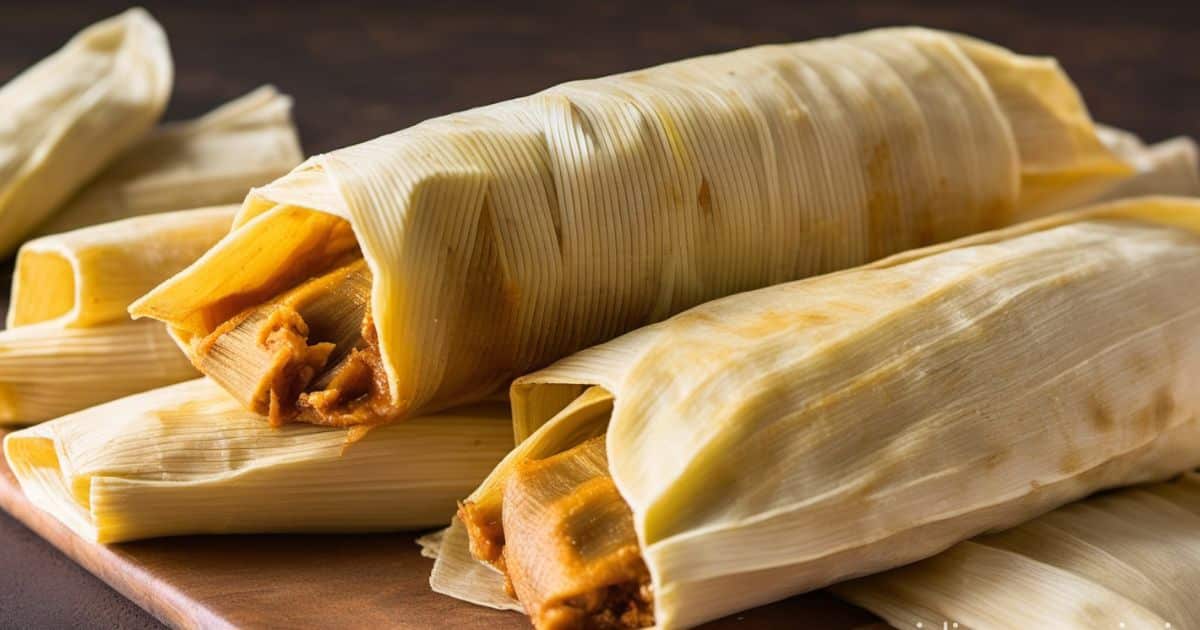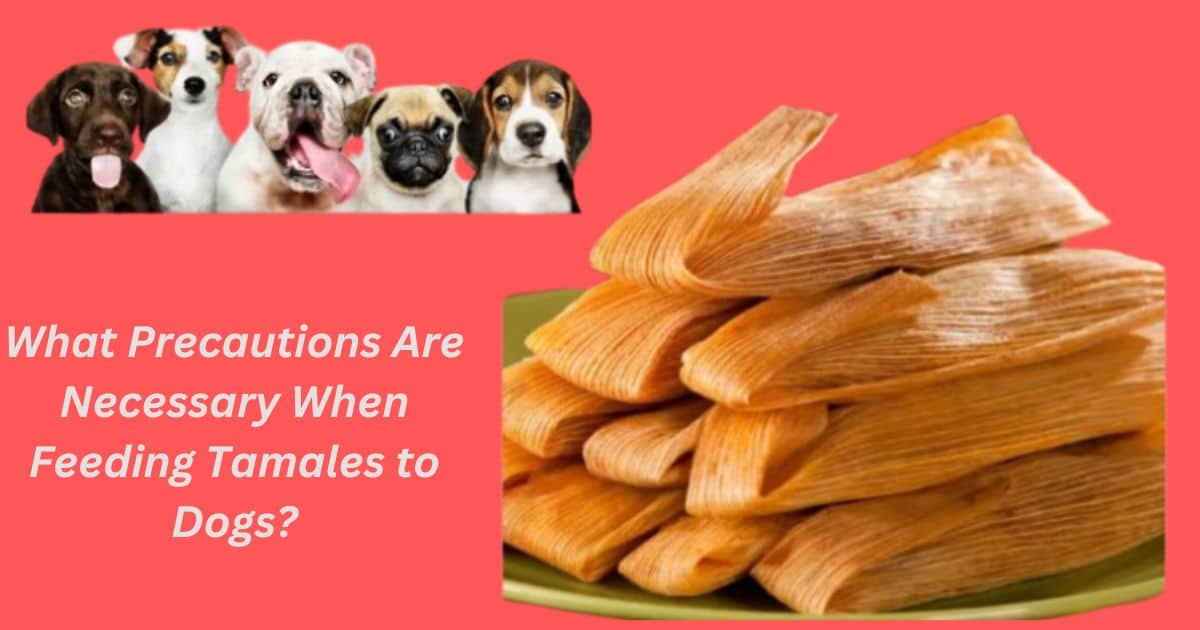Dogs should not eat tamales as they can be harmful. Tamales often contain ingredients like garlic, onion, and spices that are toxic to dogs. The high fat and seasoning content can also cause digestive issues. It’s best to avoid giving tamales to dogs to ensure their health and safety.
In this post, we’ll go over the tamales Why do Dogs Eat Tamales? Are They Good or Bad for Your Dog? Keep in mind many of the cons we’ll mention can be pros for some depending on their lifestyle.
Let’s dive in!
What Are Tamales?

Tamales are a traditional Mesoamerican and Mexican food made from masa (cornmeal dough), usually containing seasoned meat fillings and other ingredients, wrapped in corn husks or banana leaves before steam cooking. With many regional varieties incorporating diverse spices, flavors and recipes, tamale ingredients can range considerably.
History of Feeding Dogs Tamales
Some Mexican and Central American cultures have traditionally fed dogs small tamale portions or leftovers for generations without issues. However, modern mass-produced tamales contain more complex seasonings and fillings than historical homemade variants dogs may have consumed. So evidence remains unclear on benefits and risks definitively.
What Are the Effective Ingredients of Tamales?
Tamales contain various potential components, not all suitable for dogs, including:
1. Corn Masa Dough
- Plain corn dough without seasoning is often digestible for dogs. But spicy dough may cause stomach upsets.
2. Plain, Cooked Meat
- Unseasoned meats like chicken, beef or pork contain protein dogs can consume. But fatty, rich meats may cause gastrointestinal issues.
3. Plain, Steamed Corn Husk
- Corn husks are fibrous and generally pass through digestive systems without problem. But some dogs may try eating them instead of just meat fillings.
4. Plain, Cooked Veggies
- Mild produce like corn kernels are digestible for dogs when cooked. But onions, garlic and chilies can be very toxic to dogs.
So identifying all individual ingredients remains key when assessing tamale suitability for canine consumption.
How Can I Prepare Homemade Tamales for Dogs?

If trying homemade dog tamales, use the following basic guidelines:
Ingredients
- Plain corn masa dough
- Shredded plain chicken/beef/pork
- Corn kernels
- Corn husks
Instructions
- Prepare a simple fat-trimmed protein filling without seasoning
- Mix with plain masa dough and corn kernels
- Wrap small portion sized tamales in husks
- Steam until internal temperature reaches 160°F
- Allow to cool before serving dog bite-sized pieces
But first, consult your veterinarian regarding individual dogs’ nutritional needs and health conditions before homemade food preparations.
Health Risks Associated with Feeding Dogs Tamales
As human foods often incorporate seasonings and ingredients unsafe for dogs, potential tamale health risks include:
1. Blood Toxicity
Onions, garlic and chilies in tamale fillings or dough can damage oxygen carrying red blood cells when eaten, causing toxicity.
2. Gastric Problems
Spices, rich meats, corn husks and masa dough may overtax digestive systems, causing vomiting, diarrhea or constipation.
3. Pancreatitis
High fat meat fillings could trigger this dangerously inflamed pancreas condition requiring emergency veterinary treatment.
4. Allergies
Dogs may react allergically to corn, meat or dough ingredients with itchiness, upset stomachs or other symptoms.
So tamales pose various health considerations requiring caution around dogs.
What Precautions Are Necessary When Feeding Tamales to Dogs?

If owners opt to share tiny tamale portions after consulting veterinarians, they should implement vital precautions like:
1. Remove Harmful Ingredients
Analyze all individual contents first, eliminating onions, garlic, unusual spices, chilies, etc.
2. Avoid Spices
Even “dog-safe” spices may cause stomach irritation. Plain fillings are gentler.
3. Minimal Chunk Size
Bite-sized pieces prevent choking while enabling digestion.
4. Seek Allergic Reactions
Observe dogs carefully following initial tamale licks, stopping at any symptoms.
5. Consider Individual Health Conditions
Dogs with sensitivities should avoid novel foods like tamales.
6. Feed in Extreme Moderation
Tiny meat pinches inside discarded husks maximize safety.
Vigilance around reactions remains vital when unfamiliar foods get introduced.
Why Are Tamales Not Great for Dogs?
Dogs eating tamales face risks from potentially toxic seasonings and fatty/spicy fillings that can cause gastric illnesses. Ingredients like bones or corn husks in commercially produced human tamales can obstruct intestines, posing safety issues. Safer chew treats and toys exist, protecting canine health.
Are Tamales Good for Dogs?
In extremely small, plain portions with absolutely no toxic seasonings or spices, homemade tamale ingredients like corn, chicken and beef could be digestible nutrition sources for dogs after veterinary consultations. But given easier, safer diet options available, tamale introduction appears an unnecessary risk.
Are There Any Store-Bought Tamales Healthy for Dogs?

No commercial dog food tamales produced specifically for safe canine consumption currently exist. As human-grade tamale products routinely incorporate onions, garlic, capsicum spices and other dangerous seasonings during preparation for flavor, no store-bought tamale products represent completely non-toxic options out the package for dogs.
So without any veterinary-prescribed therapeutic diets or officially approved dog tamale chew products available yet, owners should not consider any unverified human tamales as guaranteed safe for canines, even in tiny amounts. Potential toxicity risks remain too unpredictable across batches.
Can My Dog Eat Canned Tamales?
No canned tamale products designed especially for dog consumption exist currently. And tinned human tamale variant ingredients would generally pose similar toxicity risks to dogs as homemade or frozen tamales in regards to potential seasonings used. So unless prescribed by veterinarians for special medical needs, canned tamales do not represent vet-recommended options for store-bought dog snacks.
What Should I Do If My Dog Eats Tamales?
If dogs access tamales accidentally, monitor closely for any vomiting, diarrhea, choking or allergic reactions. Contact emergency veterinarians immediately if symptoms manifest, detailing any ingredient exposures. Inducing vomiting may be recommended to expel contents before absorbing. Try capturing any leftover tamale parts to help identify seasonings. Prompt transparent descriptions also assist vets treating illnesses rapidly and effectively if needed.
Frequently Asked Questions (FAQs)
Are Cheerios safe for dogs to eat regularly?
Cheerios, in small quantities, are generally safe for dogs as an occasional treat. However, they should not be a regular part of a dog’s diet due to their limited nutritional value for canines.
What type of Cheerios is safest for dogs?
Plain Cheerios are the safest option for dogs, as they have the least amount of sugar and no artificial flavors or colors. Avoid flavored varieties like Honey Nut or Chocolate Cheerios, as they contain additional sugar and ingredients that may be harmful to dogs.
Can Cheerios help with a dog’s digestion?
Cheerios are low in fiber and not particularly beneficial for a dog’s digestion. If you’re looking for foods to aid in digestion, there are better options specifically formulated for dogs.
Can Dogs Eat Tamales?
Dogs should not eat tamales. While the basic ingredients in tamales, such as corn dough, are not toxic to dogs, the spices and added ingredients like garlic and onion can be harmful. Additionally, the high-fat content and husks can lead to digestive issues.
What Ingredients in Tamales Are Harmful to Dogs?
Ingredients in tamales that are harmful to dogs include onions, garlic, and certain spices, which can cause gastrointestinal upset or even be toxic. The fat content in tamales can also be problematic, potentially leading to pancreatitis.
What Should I Do If My Dog Eats a Tamale?
If your dog eats a tamale, monitor them for signs of gastrointestinal distress such as vomiting or diarrhea. If symptoms occur or if the tamale contained toxic ingredients like onion or garlic, consult your veterinarian immediately for advice.
Conclusion
In conclusion, tamales are not suitable for canine consumption due to their potentially harmful ingredients and high fat content. Ingredients commonly found in tamales, such as onions, garlic, and certain spices, are toxic to dogs and can lead to serious health issues, including gastrointestinal upset and anemia. Moreover, the high fat content in tamales can cause pancreatitis, a painful and potentially life-threatening condition in dogs. Therefore, it is essential to avoid feeding tamales to dogs to protect their health and well-being. Opting for dog-safe treats is the best way to reward your pet while ensuring their dietary safety. Learn more information about “Can Dogs Have Scooby Snacks?“









